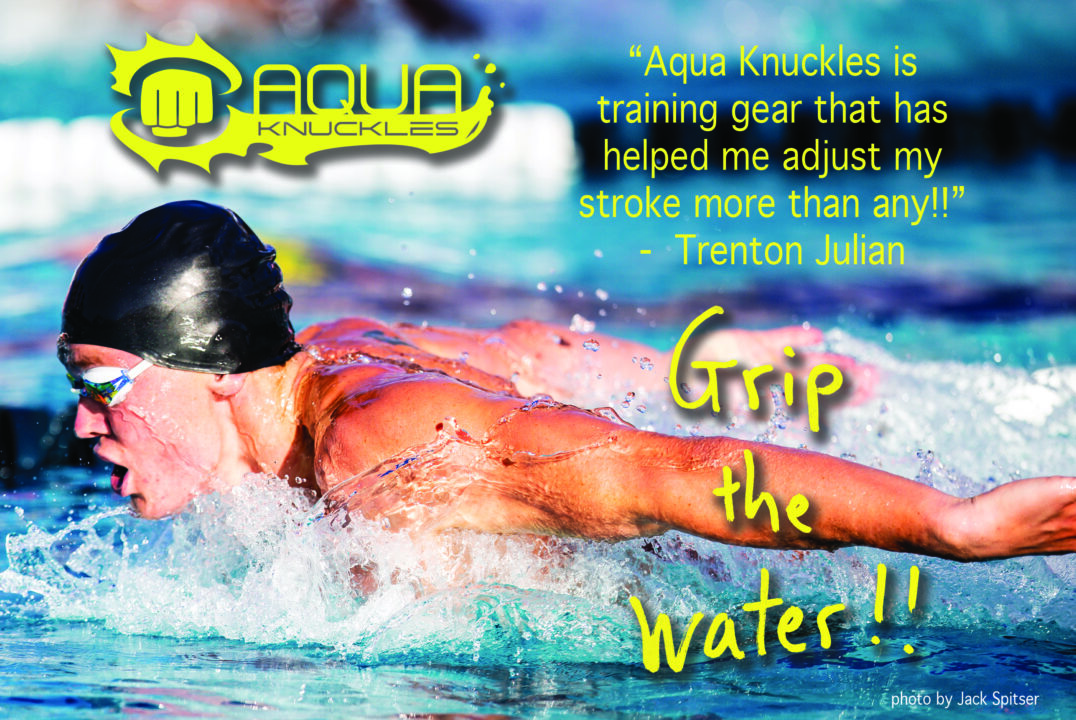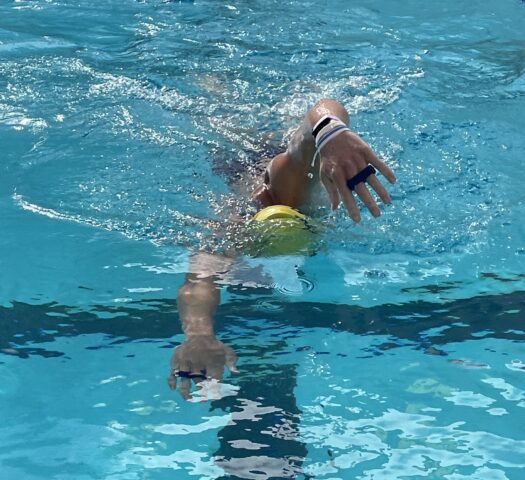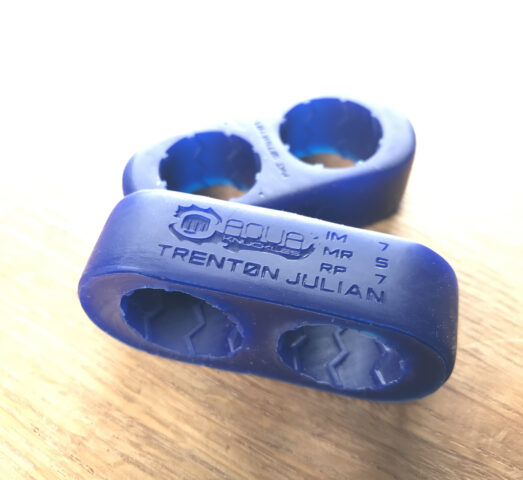Courtesy of Aqua Knuckles, a SwimSwam partner.
How does it feel to be a professional swimmer without the academic commitments of swimming while also going to school?
I enjoy the freedom that comes with being a professional swimmer, having a much stronger focus on everything in and out of the water that will make me better.
Do you still have early morning practices as a Pro swimmer?
Yes, although the earliest we start is 7 am. The extra hour of sleep doesn’t sound like a lot, but never having to be up when the hour starts with a 5 is a world of difference.
How is your new Pro training group in Mission Viejo going?
I love the group we have so far, even though we are all pros with our individual schedules it still feels like a tight-knit group that gets along really well.
How is it different from training with Cal?
Training with this group is much different than the college environment at Cal. It is a much smaller group, meaning we have to keep ourselves accountable when it comes to paces and speeds, since we don’t always have someone to race next to us. Although, similar to Cal, I can feel that everyone is there to get better
Are you ever able to utilize Aqua Knuckles during your training in Mission Viejo?
Since I have more freedom in my schedule and workouts, I can look more in the future at when I want to incorporate Aqua Knuckles, instead of deciding during the day if its a good practice to use them or not. So far, I have tried to not overuse them, but as I get back into the full training schedule I will look to utilize Aqua Knuckles on a much more daily basis.
How is it swimming for your father again?
It was one of the main reasons I wanted to come train with this pro group. I fully trust the training I get from my Dad and it’s a lot easier for me to voice my opinions
What was your favorite meet this year? Why?
This year’s NCAAs was probably my favorite meet, although I would say it had nothing to do with how I raced as an individual, since I was honestly very disappointed in my own performance. What made it the best was the experience of winning the title with that group and being able to come back for a fifth year to help them accomplish our goal.
What was your favorite race this year? Why?
I think the mystery 200 IM was my favorite race because it was something that I had never really done before, and it honestly was a lot of fun!
You won the mystery 200IM at Duel in the Pool in Australia in August. Did you get to choose the order of the strokes for the mystery IM at Duel in the Pool or was the order given to you?
For the mystery 200 IM, all orders were decided for the swimmers ahead of time and when we walked out onto the pool before the race was the first time we saw our order.
Was that an event you knew about going into the meet? If so, did you train for it?
I had an idea that I might swim it going into the meet, but nothing in the schedule was set in stone. To be prepared for any situation, I ended up doing a little more IM training, suiting up for a broken mystery IM, and practicing every variation of turn that would be different from a normal IM turn.
How was it swimming in meets in Australia?
Amazing! The energy from the crowd was so different than any meet I had ever been to, and I had so much fun getting to know other swimmers from Australia.
We’ve heard Australians really embrace the sport of swimming much more than Americans do. Do you think that’s true?
I really think it is. The community in Australia rallied behind swimming much more than any swim meet in America. I think swimming is known a lot more in Australia and people enjoy the sport much more.
What differences did you notice between swimming in Australia and swimming in the U.S.?
It’s hard to find exact differences between the two. There were some minor details during the meet and about how the meet was run that was different. Other than that, they are both elite countries in swimming and the country treats them as such.
You’ve been traveling internationally for swim meets this year. That must be hard on your sleep schedule. Do you have a process for helping you get on the local time schedule during international trips?
The past couple of years I have actually started using a meditation app called Headspace for helping me fall asleep and get better sleep. I also just recently started wearing a Whoop which tracks my sleep metrics, helping me better understand my sleep needs in order to more smoothly acclimate to the local time.
Swimming is the most popular Olympic sport in the U.S. as far as audience viewership and there are more than a million competitive swimmers in the U.S. Do you think a professional swim league is possible someday in the United States?
I think there is a long way to go before a swim league in the United States is possible, although I do hope I can be a part of it. Right now, there is so much importance put on swimming as just an Olympic sport that when it isn’t an Olympic year the viewership and attention swimming gets is much lower.
What events do you see yourself focusing on over the next twelve months?
I don’t think I see a specific event or two that I will be focusing on, but I do want to get back to my IM training again so that I am ready for everything. The last year and a half I wasn’t able to train as much IM and noticed a difference pretty quickly.
How did you get better at underwaters when you were coming up in the sport?
Getting better at underwaters is all about repetition to me. Even if I don’t have the best underwaters in the field, I still want to make sure that when I do them, they are faster than my swimming. My main focus at first was always hitting a certain number of underwater kicks whenever I was pushing off the wall and if I did 200 pace work then I had to take the same amount of kicks I would in the event.
As a Pro swimmer, do you have certain practices dedicated to underwaters?
Since I am mainly looking at long course training, there isn’t as much dedicated to underwaters by itself, although there are sets within a practice that are meant to warm up the lungs and legs by doing more underwater work.
Do you eat or drink anything before morning practices?
Usually, I will either have a bar or two and just water when I wake up, although if I have a little more time with a 9AM practice then I would prefer oatmeal or something more substantial since I haven’t eaten in so long.
Are you a breakfast, lunch or dinner person?
My favorite would definitely be breakfast, but since I have a lot of morning practices, those are kept to just bars or oatmeal so I don’t feel bloated during practice.
Are you careful about what you eat – or do you often have junk foods because swimmers can eat a lot of calories?
I used to not pay attention to what I eat at all and just had what I liked or would prefer. Recently, I have started to look a lot closer at what I am eating and limiting the junk food or foods that could cause me to have a higher chance of injury or even just feeling bad in the water. There isn’t a specific diet I stick to, just trying to eat what I like that is keeping me ready to swim at the highest level.
When you’re at a meet – do you warm up until the very last minute or do you give yourself some time before events?
I prefer to warm up until right before I get into my tech suit, since I like my tech suit to be dry when I get behind the blocks, I don’t get in the water to warm up again once I get out of my first warm up.
What meets will we see you in over the next six months?
So far, my schedule going forward looks like the last two world cup meets, short course worlds if I am invited.
What will be your taper meet?
Taper meets are looking at possibly short course worlds and the next long course international selection meet.
Please follow Trenton’s Instagram for more exciting news –
View this post on Instagram
The science of Open Finger Swimming
When swimmers pull through the water with their fingers slightly opened (about 5-10 mm apart), they push more water. Water does not escape through slightly spread fingers. As the hands enter the water, they form a thin boundary layer. The water closest to the hand sticks to the hand to form this layer. The boundary layer is like a glove on the hand, adding more surface area to your hand. How thick the boundary layer is will depend on the speed of your hand through the water and the shape of your fingers. When you spread your fingers, water gets trapped between the spaces of your fingers because of this boundary layer. This effectively increases the surface area of your hand.
Golf balls have been taking advantage of the boundary layer for years to achieve better distance and control. The dimples on a golf ball create a thinner boundary layer that stays closer to the ball’s surface. This helps the air flow tighter to the surface of the golf ball creating less of a wake. The dimples on a golf ball reduce the drag by half. In swimming, we are trying to increase the drag from our hands.
Spreading the fingers gives the hands more surface area. Spreading your fingers is accomplishing the same effect as wearing paddles and is easier on your shoulders than paddles. You can’t wear paddles during a race, but you can spread your fingers during a race for a similar effect. The pull is a very important part of the stroke. The more powerful you can make your pull, the more powerful your stroke is. Wearing Aqua Knuckles offers the swimmer the ability to get very precise with his/her finger placement on one of the most important aspects of the propulsion of the stroke – the hand surface area. Using Aqua Knuckles really helps create a precise finger position which can be hard to accomplish otherwise. There are multiple scientific papers online and now some videos comparing open-finger swimming to closed-finger swimming. The papers all indicate that open-finger swimming is a better method of generating a more powerful pull by increasing your hand-surface area by as much as 10%. On a side note, we’ve also discovered that wearing Aqua Knuckles decreases stroke count.
Open finger swimming also increases the nerves exposed to the water by up to 35%. When you swim with closed fingers, the sides of your fingers are not getting exposed to the water. When a coach talks about “feel for the water”, this is how you can feel more. Having a better feel for the water helps swimmers make those micro adjustments to their pull, helping them swim faster. Some coaches believe the best swimmers’ edge is having a better feel for the water.
What are Aqua Knuckles?
Aqua Knuckles are training aids worn during swim practice for competitive swimmers and anyone who wants to move through the water faster (surfers use them, too). Aqua Knuckles are double silicone bands slipped over the ring and middle fingers of each hand. They are sold in pairs and follow ring finger sizing, though many swimmers prefer a snug fit.
Use Code SWIMSWAM15 to get 15% off your next purchase.
Socials
John O’Grady – Founder, Aqua Knuckles
John has been a competitive swimmer for nearly 40 years and is a real student of the sport. His love of the water has seen him through age-group swimming, high school teams, Divisions I and II college teams and masters swimming. He has competed in open water competitions in the Atlantic Ocean and has practiced in the English Channel. It is hard to find this guy out of the water! Currently raising his large family of competitive swimmers in Southern California, John is an assistant swim coach at a local high school. When he is not in the water or on a pool deck, John runs a boutique media services company focused on creative projects of all kinds for both large and small entities. He enjoys cooking, surfing, travel, photography and spending time with his wife and children.


